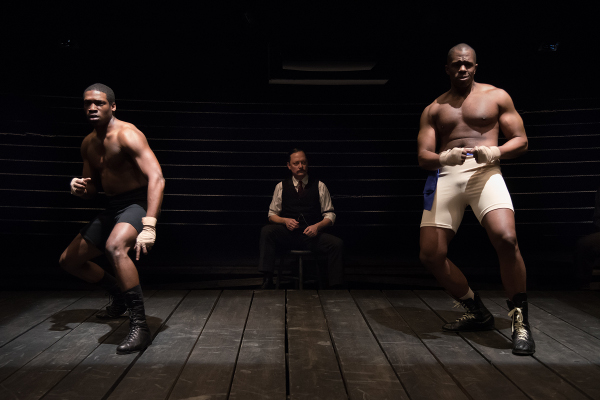
THE ROYALE scores a knockout for the Rep’s Studio
-By Cate Marquis –
The Repertory Theater of St. Louis finishes out the Studio season for its 50th anniversary with a knock-out punch of a drama, THE ROYALE. The play was inspired by the real boxer Jack Johnson, who became the first African American to captured the title of World Heavy Weight Champion in the early years of the 20th century, but this gripping drama is less about boxing and more about race and ambition. Johnson was a brash personality whose flashy lifestyle engendered nearly as much racist outrage as his boxing title. With electrifying staging and riveting performances, THE ROYALE explores these subjects with depth, intelligence and real muscle.
THE ROYALE is one of Rep’s best, this season or any other, and a likely contender for next year’s Critics Circle Awards. The story is set between 1905 and 1910, as the mechanical marvels of the 20th century such as automobiles, radio and record players are just appearing. New black musical forms like jazz were in the air, along with an expansive atmosphere. It was a time of rising opportunities and ambitions for African Americans but tempered by growing white racist backlash like race riots and the revived Ku Klux Klan.
The play, which is performed without intermission, is like a juggernaut, a wild ride drama that grips us and takes us down. We first meet charming champ Jay “The Sport” Jackson as he steps into the ring, introduced by his white manager/promoter Max (Lance Baker) who also plays the role of ring referee. The bout is an exhibition fight and his opponent is a young boxer named Wynton (Samuel Ray Gates) in his first professional fight. The champ defeats him but hires the young fighter as a sparring partner. Along with Jay’s trainer Fish ((Bernard Gilbert), the trio of men make up the team about the charismatic, restless champ. Ambitious to prove himself against racist questions about his right to the World Champion title, Jay wants to set up a bout with the white former champ, who retired undefeated, a decision that exposes the toxic reach of violent racism. Up to this point, the male perspective, with pride, ambition and bravura, has dominated the characters’ discussions. This juggernaut of male pride is brought up short by the arrival of Jay’s older sister Nina (Bria Walker) who raises a host of deeper and more personal issues. Besides the principle characters, two more actors, Maalik Shakoor and Jarris Williams, play a number of supporting characters who help paint a picture of the era.
The acting is outstanding, often sending chills through the audience with the sheer power of the dialog and confrontations. All the actors are strong, Baker in particular as the sometimes sly promoter, but Watson virtually radiates power as Jay, a man of such vaulting ambition and self-confidence that he aims to shut down racist barriers single-handedly. As the sole woman in this story, Walker turns the tables on the male viewpoint, putting what has gone before in new light, and revealing layers of fear, hopes, dreams and even love.
Staging is one reason why this production is a winner, and the prefect presentation of the fiery drama. The production uses the intimate space of the Studio theater to great advantage. The audience is on three sides of a stage that resembles a boxing ring without ropes. Ropes run the length of the back wall, where the actors often stand when not in the center of the drama, providing a kind of Greek chorus of commentary.
The fights are staged in a unusual but very effective way, with the actors standing side by side, throwing their punches and engaging in banter. The technique gives us the point of view of each fighter simultaneously. A line of actors along the back wall, with is decorated with the ropes of a boxing ring, add percussive, stomping sound effects for the blows, as well as commentary like a Greek chorus.
The stage surface also serves as a percussive sound board for the actor’s feet, allowing their stomping to recreate the sound of blows as well as adding a percussive sound track to the story. Stephanie Paul created the movement and body percussion for the play, elements that heighten the drama and add a unique flavor.
The lighting adds to the power of the drama, as do other elements of scenic design by Brain Sidney Bembridge. Harsh spotlights create the feel of the ring, and the stage is transformed into other locations but the addition of a few props. Some props descend from the ceiling, such as the announces microphone or the chandelier of the champ’s lavish home, while others are brought on stage by actors, such as a fancy arm chair and a portable record player.
The play ends with an emotionally powerful scene, that propelled the audience out of their seats at its end. THE ROYALE is knockout of a drama – dramatically gripping, emotionally moving and intellectually provocative, a tale of ambition and dreams against tide of social opposition. It is the best of the Studio performances, in what has been a very strong season. This is one show you don’t want to miss.
© Cate Marquis
